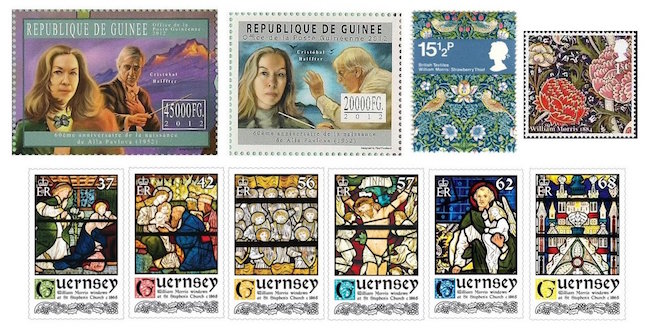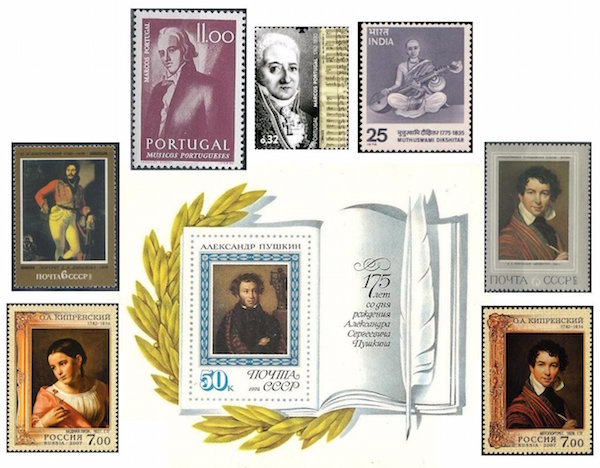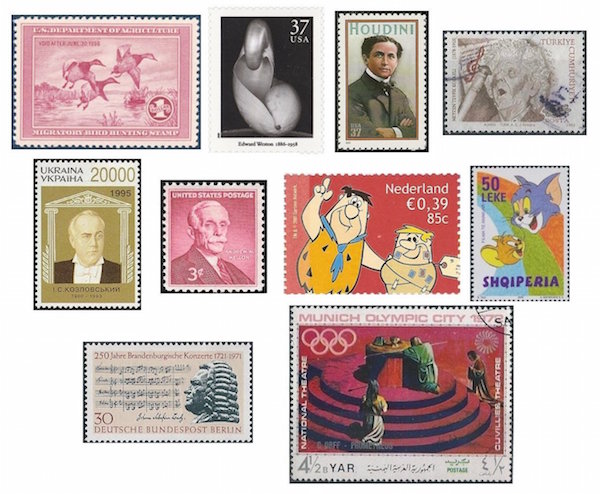The Arts on the Stamps of the World — March 24
An Arts Fuse regular feature: the arts on stamps of the world.

By Doug Briscoe
Lawrence Ferlinghetti turns 98 today, but we must wait before he gets a stamp.
Spanish composer Cristóbal Halffter, however, who turns 87 today, is already represented on two stamps from Guinea. These items come from souvenir sheets that are mainly devoted to Russian-born composer Alla Pavlova (not to be confused with the dancer Anna Pavlova). The only concrete connection I can find between the two is that Pavlova dedicated her 2012 Concertino for violin, piano, and strings to Halffter. Her Wikipedia article also tells us that when the September 11 attacks took place, works being written at the time by both Pavlova (the song, “Miss me… but let me go”) and Halffter (Adagio en forma de Rondó) were dramatically changed by the events. Cristóbal Halffter Jiménez-Encina (b. Madrid, 24 March 1930) is a composer and conductor from a distinguished family of Spanish composers, most notably his uncles Rodolfo and Ernesto Halffter. He is considered to be the most important figure of the group Generación del 51, referring to those composers from the Basque and Castilian-speaking regions of Spain born between 1924 and 1938. Halffter’s teachers included Alexandre Tansman and André Jolivet. In the 1960s he was professor and then director of the Madrid Royal Conservatory. Halffter’s music includes the operas Don Quijote (2000), Lazarus (2008), and Schachnovelle (2013, based on the magnificent novella The Royal Game by Stefan Zweig—read it!); two concertos each for piano, violin, and cello (the Second was recorded by Rostropovich); and seven string quartets, along with numerous other chamber and choral works.
March 24 is also the birthday of the great English artist in both images and words William Morris (1834 – 3 October 1896). Perhaps his work as a textile designer is best known today, and two British stamps, one from 1982, “Strawberry Thief”, and the other from 2011, “Cray furnishing fabric”, focus on that aspect of his work (though both of those stamps come from sets celebrating textile designs by various artists). But he also wrote poems and novels, among them the utopia News From Nowhere (1890) and the fantasy The Well at the World’s End (1896). From youth an admirer (and idealizer) of the Middle Ages and decrier of the evils of industrialization, Morris fell right in with the precepts of the Pre-Raphaelites like Burne-Jones and Rossetti who were his friends. He also translated Icelandic sagas, worked on social issues, and cofounded the decorative arts company Morris, Marshall, Faulkner & Co.—after 1875 simply Morris & Co.— which among other things produced stained glass windows. One of the company’s earliest projects (1865) was to provide windows for St. Stephen’s Church on the island of Guernsey, several of which are seen in a set of stamps issued just two Christmases ago.

Marcos António da Fonseca Portugal (March 24, 1762 – February 17, 1830), sometimes styled Marco Portogallo, was a Portuguese composer active in Lisbon, Italy, and Brazil. He had close ties to the Portuguese royal family, but in the 1790s lived in Italy, where he produced 21 operas for various theaters. Otherwise he is mostly known for his sacred music. He was called to the Portuguese colony of Brazil in 1811 to serve as music master to the children of the Prince Regent as well as Royal Composer. He died a Brazilian citizen in Rio de Janeiro in 1830.
South Indian poet and composer Muthuswami Dikshitar (March 24, 1775 – October 21, 1835) is held to be one of the “Trinity of Carnatic music” (one of the two main subdivisions of Indian classical music) along with Tyagaraja (1767–1847) and Syama Sastri (1762–1827). While they wrote in the Telugu language, however, most of Dikshitar’s compositions, some 500 of them, are set in Sanskrit. He is the composer of the Kamalamba Navavarna cycle, considered one of the masterpieces of the genre, along with many other cherished pieces in the tradition. Though born in the south, in what today would be the state of Tamil Nadu, he traveled throughout India in his youth and even encountered western music during his time in Chennai (Madras) and adapted a few dozen western folk songs into ragas.

Russian painter Orest Kiprensky (24 March [O.S. 13 March] 1782-17 October [O.S. 5 October] 1836) was born illegitimate near St. Petersburg and took his name from the goddess of love, Kypris (a Greek variant of Aphrodite). His father did not abandon him, however, arranging for his education at the Imperial Academy of Arts. Kiprensky won first prize in 1805 and broadened his knowledge of art with a European excursion. Back in Russia he became celebrated as the leading portrait painter of his day and left a famous portrait of Pushkin (1827), seen at the center of our Kiprensky display as the single stamp in a 1974 minisheet. At upper left is his Portrait of Yevgraf Davydov (1809), and at bottom left a picture known only as Poor Lisa (1827); at right, two stamps of Kiprensky’s Self Portrait of 1828, one from a 1973 USSR issue, the other issued by post-Soviet Russia in 2007.
American painter Frank W. Benson (March 24, 1862 – November 15, 1951) was born in Salem, Massachusetts. He and his siblings were encouraged to lead active lives in childhood, including hunting, from which Benson developed a love of birdwatching and a desire to become an ornithological illustrator. He studied at the MFA and in Europe with a generous allowance from his parents and absorbed the influences of seventeenth-century masters and of Impressionism. Later he produced Realist portraits. His early love of painting birds gives me the opportunity—or the excuse—to show one of the United States’s duck hunting stamps, which came about after Herbert Hoover’s signing of the Migratory Bird Conservation Act in 1929 and its subsequent Migratory Bird Hunting Stamp Act, signed into law by FDR. These stamps, consistently beautiful in design, whether or not one takes issue with the purpose, have been issued since 1934, and Benson’s work was used for the second one in the series, issued in 1935.
Another American artist, from the next generation, was photographer Edward Henry Weston (March 24, 1886 – January 1, 1958), born in Illinois to an obstetrician and a Shakespearean actress, who unfortunately died when Weston was only five. His father, who remarried and seems to have paid more attention to his new family than to Weston and his sister Mary, did give young Edward his first camera for his sixteenth birthday. After one of his photographs was published in a magazine in 1906, Weston relocated with his family to California to be close to his sister. He became the romantic and professional partner of photographer Margrethe Mather in the first in a series of Weston’s adulterous relationships with his models and muses. He was inspired by the paintings of seashells by the Canadian artist Henrietta Shore (neither, I guess, a model nor a muse) to photograph such objects. The most famous of these is Nautilus of 1927, but the stamp shows us another from that series and year, called simply Shell.
Our third consecutive American (though Hungarian-born) is no doubt the most famous: Harry Houdini. This is the first occasion we’ve had to salute an illusionist here, but it seems to me the craft has more than a little art to it, and it’s not too far a stretch to call Houdini an Artist and not merely an escape artist. At the same time, his story is well enough known that I don’t propose to go into much biographical detail. He was born Erik Weisz to Jewish parents in Budapest on March 24, 1874, came to the US with his family when he was four, and after a lifetime of extraordinary and even incredible accomplishments (some of his tricks remain unexplained to this day) died of peritonitis on October 31, 1926. He was honored on a US stamp in 2002.

The Turkish poet who went by the name of Neyzen Tevfik (March 24, 1879 – January 28, 1953) was born Tevfik Kolayli in Bodrum (ancient Halicarnassus on the Mediterranean) and learned to play the ney, a Middle-Eastern flute (as seen on the stamp), when he was a child. Thus the pen name “Neyzen”, which means ney player, for which he is celebrated in Turkey as much as for his writing. He also began experiencing in childhood the epileptic seizures that troubled him all his life, exacerbated by his alcoholism. His first poem saw publication when he was 19, and he went on to a career of writing satirical verses critical of societal injustice and frequently finding himself under arrest or even sent into exile, as he was in 1903, when he was banished to Egypt. He had joined the Bektashi Order of dervishes in the preceding year, but was never reticent in pointing out clerical abuses. He died in Istanbul.
Ukrainian lyric tenor Ivan Semyonovich Kozlovsky (March 24 [O.S. March 11] 1900 – December 21, 1993) lived under what might be called a mixed blessing. One of his most ardent admirers was Joseph Stalin, who used to call upon Kozlovsky at all hours to give private command performances. He was never permitted to leave the Soviet Union. In compensation, he was one of the best known stars of Soviet opera and a producer and director of his own opera company, the VTO Soviet Opera Ensemble, which he founded in 1938. Koslovsky sang in a monastery choir from the age of seven and attended the Mykola Lysenko Institute of Music and Drama in Kiev (we just celebrated Lysenko’s birthday the day before yesterday). He appeared with various opera companies—Poltava, Kharkiv, Yekaterinburg (then called Sverdlovsk)—before joining the Bolshoi Theatre, where he remained from 1926 to 1954, taking the lead in fifty operas. He was a champion of Ukrainian operatic and folk music and paid for the construction of a music school in his home village. Kozlovsky also taught singing at the Moscow Conservatory from 1956 to 1980 and died in that city at the age of 93, so he had forty years without Stalin breathing down his neck.
We offer a nod to two Americans in widely disparate fields. Philanthropist and art collector Andrew Mellon (March 24, 1855 – August 26, 1937) donated his extensive collection, valued at the time at $40 million, and $10 million for the construction of the building, to the National Gallery of Art in Washington, D.C. A businessman from a wealthy family, Mellon also served as Ambassador to the United Kingdom and Secretary of the Treasury. Joe Barbera (March 24, 1911 – December 18, 2006), meanwhile, of Hanna-Barbera fame, was a cartoonist, storyboard artist, and animator whose creations The Flintstones and Tom and Jerry are acknowledged on stamps from the Netherlands and Albania respectively.
On this day in 1721 (three days after his birthday), Johann Sebastian Bach dedicated the Brandenburg Concertos to Margrave Christian Ludwig in hopes of getting a job. He didn’t. But a stamp specifically remembering the 250th anniversary of the Concertos was issued by Germany in 1971.
Another stamp that happens to have come out the same year cites Carl Orff’s penultimate opera Prometheus (based on the ancient Greek of Aeschylus), which had its first performance on this date in 1968 in Stuttgart under Ferdinand Leitner’s direction. The stamp, one of a series anticipating the 1972 Olympics by showcasing Munich’s Cuvilliés and National Theaters, was issued by the Yemen Arab Republic.
A graduate of the University of Massachusetts with a B.A. in English, Doug Briscoe worked in Boston classical music radio, at WCRB, WGBH, and WBUR, for about 25 years, beginning in 1977. He has the curious distinction of having succeeded Robert J. Lurtsema twice, first as host of WGBH’s weekday morning classical music program in 1993, then as host of the weekend program when Robert J.’s health failed in 2000. Doug also wrote liner notes for several of the late Gunther Schuller’s GM Recordings releases as well as program notes for the Boston Classical Orchestra. For the past few years he’s been posting a Facebook “blog” of classical music on stamps of the world, which has now been expanded to encompass all the arts for The Arts Fuse.
